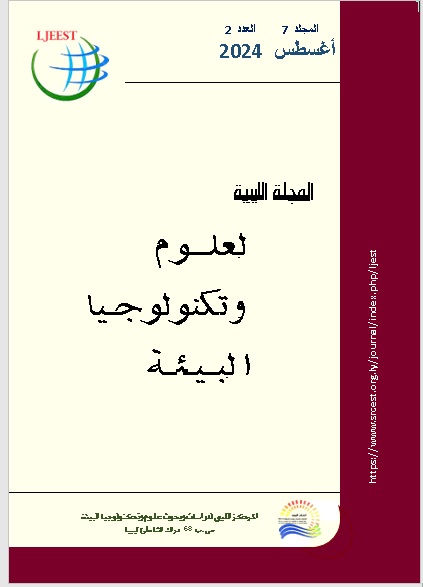تحليل عدم استقرار المنحدر والانهيارات الأرضية والمخاطر في شق الطريق السريع
DOI:
https://doi.org/10.63359/f5cava93الكلمات المفتاحية:
عدم استقرار المنحدرات، شق الطرق، تساقط الصخور، الانهيارات الأرضية، المخاطرالملخص
يُعد استقرار المنحدرات الصخرية أمرًا بالغ الأهمية للسلامة العامة في الطرق السريعة التي تمر عبر قطع الصخور. حيث يحدث عدم استقرار المنحدرات وانهيارها بسبب العديد من العوامل مثل هندسة المنحدرات المعاكسة، والانقطاعات الجيولوجية، وضعف مواد المنحدرات أو تآكلها، بالإضافة إلى الظروف الجوية القاسية. كما يمكن أن تلعب الأحمال الخارجية مثل الأمطار الغزيرة والزلازل دورًا مهمًا في انهيار المنحدر. إن الهدف الرئيسي من هذه الدراسة هو تقييم استقرار المنحدرات الصخرية على طول الطريق السريع المار واحتمالية المخاطر. ففي هذه الورقة العلمية، تم تقييم العديد من أنظمة تصنيف الكتل الصخرية لتقييم استقرار المنحدر الصخري بشكل حاسم مقابل ظروف المنحدر الصخري المعروفة في المنطقة الشمالية الشرقية من ليبيا، والتي تشمل منطقتين هما منطقة الباكور ومنطقة الشليوني الواقعة شرق مدينة بنغازي. حيث تتكون التكوينات الصخرية التي تمت دراستها في كلتا المنطقتين بشكل رئيسي من صخور الكربونات التي تمثلها الطباشير والحجر الجيري والدولوميت بالإضافة إلى الصخر الطفلة المتداخل، مع سمات المنحدرات التي تتراوح زاوية ميلها بين 70 و90 درجة. كما أن هذه التكوينات تتميز بخصائص طبوغرافية عالية وتتنوع في السُمك والامتدادات وكذلك الأنماط الهيكلية. لقد تم تحديد ظروف الاستقرار وتقييم استقرار القطع الصخري باستخدام إجراءات مختلفة، مثل تحديد أهم العوامل المؤثرة على عدم استقرار المنحدر؛ وتفسير بيانات الانقطاع التي جُمعت من المسوحات لتقييم أنماط الانهيار وتحديد مناطق عدم الاستقرار المحتملة. كما تكشف هذه الدراسة عن ضرورة تخفيف آثار القطع نظرًا لعدم كفاية بروز بعض المنحدرات الصخرية المغطاة بالشبكة المعدنية لدعم الحماية من انهيار الصخور وعدم استقرار المنحدر المستمر في بعض المناطق، بما في ذلك الانزلاقات المستوية والإسفينية وسقوط الصخور المتعرجة. وقد وُجد أن مناطق الصخور غير المستقرة تُشكل مخاطر سلامة جسيمة على حركة المرور.
المراجع
Australian GeoGuide, LR (Landslides) (2007) Coastline Hazard Management Study for the Wyong Shire Council Australian Geomechanics Vol. 42 No 1.
Burns, W.J., and Madin, I.P., (2009) Protocol for inventory mapping of landslide deposits form light detection and ranging (LIDAR) imagery. Oregon Department of Geology and Mineral Industries Special Paper 42, 30 p.
Çellek, S. (2022) Effect of the Slope Angle and Its Classification on Landslides. Natural Hazards and Earth System Sciences, 43(1), 85–95.
Chakrabarti S., Cheenikal L., Singh G. (2013) Em-bankment Design and Construction for a Major Rail Upgrade Project in Embankment Design And Con¬struction For A Major. Australian Geomechanics Journal, June, 1–8.
Ferardi F.D., Wilopo W., Fathani T.F. (2018) Rainfall Thresholds for Landslide Prediction in Loano Sub¬district, Purworejo District Central Java Province. Journal of Applied Geology, 3(1), 23–31.
Forbes K., Broadhead J. (2013) Forests and Land¬slides : The Role of Trees and Forests in the Preven¬tion of Landslides and Rehabilitation of Landslide- Affected Areas in Asia. Bangkok.
Franklin J., Robert P., Roberts D.W., Austin M. 2013. Vegetation Ecology, 2nd. Ed. In Vegetation Ecology, Jhon Wiley & Sons, Ltd, 71–106.
Freschet G., Violle C., Roumet C, Garnier E. (2018) Interactions between Soil and Vegetation : Structure of Plant Communities and Soil Functioning. In Soils as a Key Component of the Critical Zone 6: Ecology, ISTE Ltd and Jhon Wilye & Sons, Inc., 83–104.
Kimura K., Nagata T., Kan S. (2020) Landslide Di¬saster and Its Prevention Works in Shikoku Region of Japan Landslide Disaster and Its Prevention Works in Shikoku Region of Japan. IOP Confer-ence Series: Earth and Environmental Science, 589(012009), 1–12.
Kumar N, Verma AK, Sardana S, Sarkar K, Singh TN (2017) Comparative analysis of limit equilibrium and numerical methods for prediction of a landslide. Bull Eng Geol Environ77(2):595–608.
Lu P.L. (2014) Using Multiple Vegetation Layers to Reduce the Risk of Rainfall-Induced Landslides and Facilitate Post-Landslide Slope Rehabilitation. Ac¬cess International Journal of Agricultural Sciences, 2(2), 13–17.
Masannat Y.M. 2014. Landslide Hazards : Geo¬technical Aspects and Management Policies. Jordan Journal of Civil Engineering, 8(1), 1–22.
Park HJ, Lee JH, Kim KM, Um JG (2016) Assessment of rock slope stability using GIS-based probabilistic kinematic analysis. Eng Geol 203:56–69
Phillips C., Hales T., Smith H., Basher L. 2021. Shallow Landslides and Vegetation at the Catch¬ment Scale : A Perspective. Ecological Engineering, 173, 106436.
Polemio M., Petrucci O. 2000. Rainfall as a Land¬slide Triggering Factor : An Overview of Recent International Research. The 8th International Sym¬posium on Landslides in Cardiff, UK 3(January).
Pradhan SP, Vishal V, Singh TN (2018) Finite element modelling of landslide prone slopes around Rudraprayag and Agastyamuni in Uttarakhand Himalayan terrain. Nat Hazards 94(1):181–200
Russell, C.P., Santi, P., Higgins, J.D., 2008. Modification and statistical analysis of the Colorado rockfall hazard rating system. Colorado Department of Transportation Report CDOT-2008-7, 124 p.
Sarkar S, Kanungo DP, Kumar S (2012) Rock mass classification and slope stability assessment of road cut slopes in Garhwal Himalaya, India. Geotech Geol Eng 30(4):827–840.
Sardana S, Verma, AK, Singh A, Laldinpuia (2019) Comparative analysis of rockmass characterization techniques for the stability prediction of road cut slopes along NH-44A, Mizoram, India. Bull Eng Geol Environ.https ://doi.org/10.1007/s1006 4-019-01493 -3
Singh AK, Kundu J, Sarkar K (2018) Stability analysis of a recurring soil slope failure along NH-5, Himachal Himalaya, India. Nat Hazards 90(2):863–885.
Schulz, W.H., (2004) Landslides mapped using LIDAR imagery, Seattle, Washington. U.S. Geological Survey Open File Report 2004-1396, 11 p.
Schulz, W.H., (2007) Landslide susceptibility revealed by LIDAR imagery and historical records, Seattle, Washington. Engineering Geology, 89:76-87.
Vanderwater, C.J., Dunne, W.M,, Mauldon, M., Drumm, E.C., and Bateman, V., (2005) Classifying and Assessing the Geologic Contribution to Rockfall Hazard. Environmental and Engineering Geoscience, 11:141–154.
Verma AK, Singh TN (2010) Modeling of a jointed rock mass under triaxial conditions. Arab J Geosci3(1):91–103
Verma AK, Singh TN, Chauhan NK, Sarkar K (2016) A hybrid FEM–ANN approach for slope instability prediction. J Inst Eng (India) Ser A 97(3):171–180.
Verma AK, Sardana S, Singh TN, Kumar N (2018) Rockfall analysis and optimized design of rockfall barrier along a strategic road near Solang Valley, Himachal Pradesh, India. Indian Geotech J 48(4):686–699.
Verma AK, Sardana S, Sharma P, Dinpuia L, Singh TN (2019) Investigation of rockfall-prone road cut slope near Lengpui Airport, Mizoram, India. J Rock Mech Geotech Eng 11(1):146–158.
Vishal V, Siddique T, Purohit R, Phophliya MK, Pradhan SP (2017) Hazard assessment in rockfallprone Himalayan slopes along National Highway-58, India: rating and simulation. Nat Hazards85(1):487–503.
Widjaja H. (2018) Vegetative Engineering as Landslide Reduction and Handling Alternative. In IOP Conf. Se¬ries: Earth and Environmental Science, 203, 1–4.
Zhang Z., Chen Z. (2019) Constraint Embankment Construction to Prevent the Collapse Of. Advances in Civil Engineering, 2019, 1–18.
التنزيلات
منشور
إصدار
القسم
الرخصة
الحقوق الفكرية (c) 2025 المجلة الليبية لعلوم وتكنولوجيا البيئة (م ل ع ت ب)

هذا العمل مرخص بموجب Creative Commons Attribution-NonCommercial 4.0 International License.











